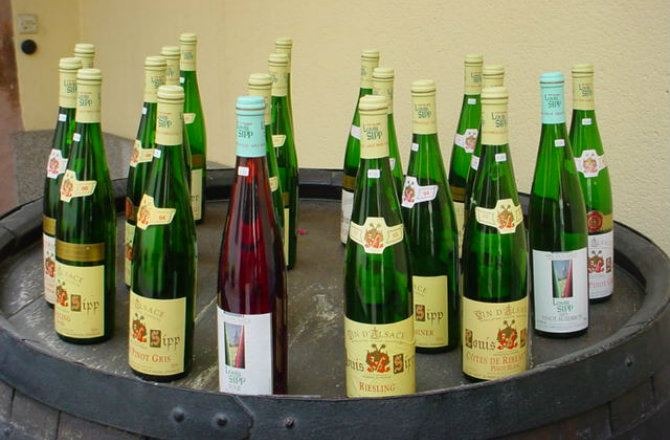Just Released: 17 Wines From Germany, Alsace
Like the crush of garden tomatoes that reward us in late summer, we have just received a crush of soothing summer wines from Germany (from the importer Valckenberg) and from Alsace. Most, but not all, are rieslings, and we even have a red wine waiting at the end for all of you who roll up your leggings and wade through the following 16 white wines.
Let's start with the two pinot blancs from Alsace, followed by two pinot gris. The 2010 Roland Schmitt Alsace pinot blanc ($19) has a soft, luscious mouthfeel and the flavors of mellow pears and cream — a pear puff? — with good acidity to clear. Moderately dry. The 2009 Mittnacht Freres Alsace pinot blanc ($17) is also soft on the palate with a savory note added, but is not as complex or as long as the Schmitt.
The 2010 Willy Gisselbrecht "Tradition" Alsace pinot gris ($16) is a little gamey in the nose, juicy on the palate, with some dark honey notes. Good presence, but not elegant, something to drink with ripe fruits. And the 2010 Blanck Alsace pinot gris ($23) is a real keeper — excellent intensity and concentration of flavors with great length and acidity and lots of citrus, spice, and minerality.
The 2011 Valckenberg Pfalz Silvaner gewürztraminer ($14) is well integrated — quite nice, mellow, lightly sweet, and mildly spicy, while the 2011 Castell Kugelspiel silvaner trocken ($28) from this much-planted and very occasionally praised variety has a little sauvignon blanc-style weediness, except it's softer. Uhhh — perhaps paired with vegetables stir-fried in soy?
On to rieslings, dry and sweet!
The 2010 Lucien Albrecht Alsace riesling reserve ($17) is a manly riesling — tangy fruits, assertive, with lots of tannin and a hint of riesling oiliness. It can keep up with any roasted chicken. The 2011 Undone Rheinhessen dry riesling ($11) with the corset on the label shows the greener side of the grape — a lot of tart apples — with some dusty tannins, while the 2011 Liebfrauenstift Rheinhessen dry riesling ($19) has a more-floral, spun-sugar nose, yet is lean and dry with good acidity.
Now, two wines which are pricier and each exquisite in their own ways. In the normal course of things, I wouldn't see the need to decant a dry riesling, but both of these fly just out of the bottle tightly wound and need some air to blossom. The 2011 Johannishoff Rheingau "Charta" riesling ($25) is very citrusy — orange peel — very concentrated with some honeysuckle notes in the finish and aromatic bitters around the edges. The 2010 Kesselstatt Josephöfer Mosel GG riesling trocken ($67) is one of the finest food rieslings I've had in a long time — very elegant with a lean tartness, excellent intensity of fruit and structure, and a savory spiciness. I would love to have this with a lobster quiche.
Moving on to sweeter things: The 2011 Joh. Jos. Prüm Mosel riesling kabinett ($24) seems to be having an off day with a very vegetal nose, a bit tangy, and quite assertive. The 2011 Two Princes Nahe riesling ($13) is pleasant with a little sugary sweetness and matching acidity, although the two aren't as harmonious as they might be. The 2011 Knyphausen Baron K Rheingau riesling kabinett ($18) has a little more fruity personality — nice notes of apricot — but the sweetness is a tad clingy at the end.
My nice-for-the-price wine is the 2011 Carl Graff Graacher Himmelreich mosel riesling spatlese ($17), with its honey and citrus flavors, good body, and length on the palate, and my sweet-thang award goes to the 2011 Schloss Saarstein Saar riesling spatlese ($38). It is delicious, both elegant and big, with a good mix of honey and citrus and great acidity and length. It will also age well.
If you're still with me, we will reward you with a pretty nice German red — the 2010 Bernhard-Huber Baden pinot noir ($37), which is quite similar to the real thing from Burgundy — dark cherry flavors with a little gaminess and a finishing tang with some savory spices.
(Photo Ribeauville Modified: Flickr/Andreea/CC 4.0)
